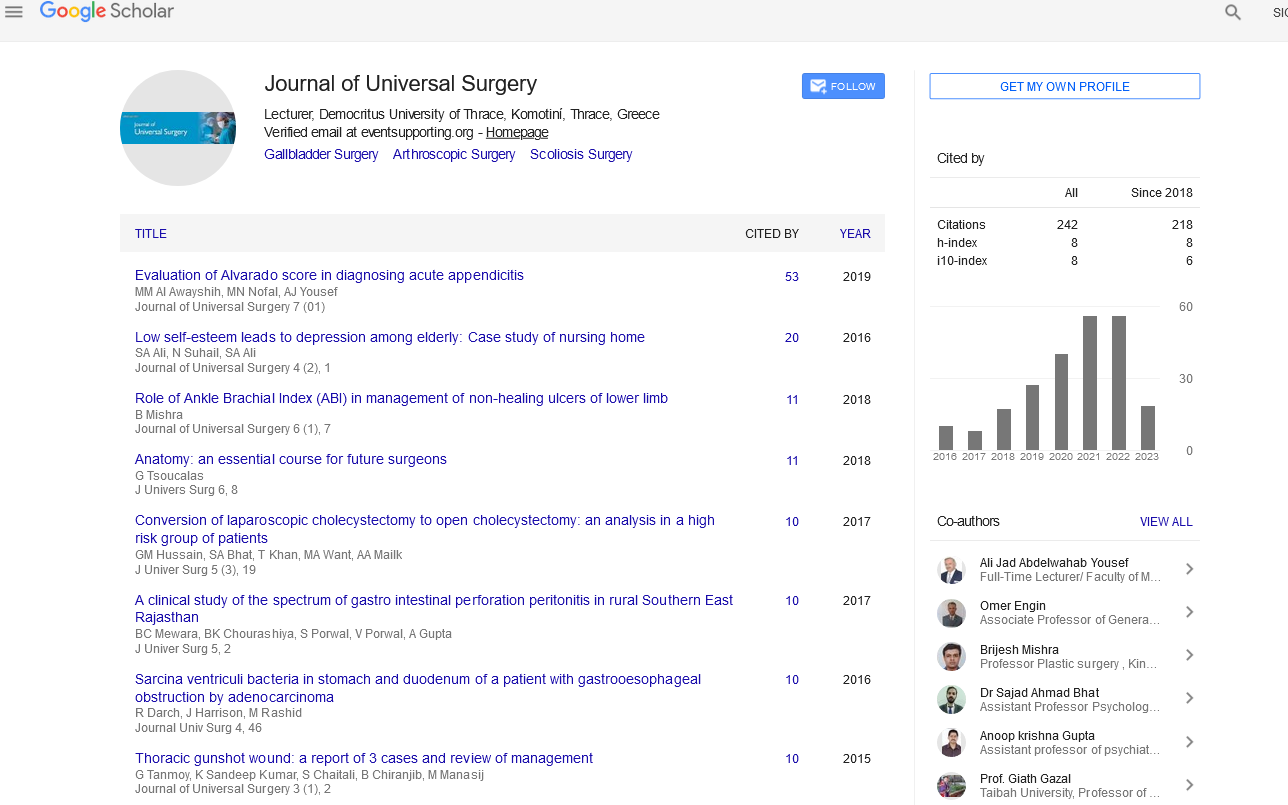Perspective - (2024) Volume 12, Issue 3
Outcomes of Post Hip Fracture Surgery
Carlos Dellett*
Department of Orthopedic Surgeon, Unversity of Mar del Plata, Mar del Plata, Argentina
*Correspondence:
Carlos Dellett, Department of Orthopedic Surgeon, Unversity of Mar del Plata, Mar del Plata,
Argentina,
Email:
Received: 15-May-2024, Manuscript No. IPJUS-24-14865;
Editor assigned: 20-May-2024, Pre QC No. IPJUS-24-14865 (PQ);
Reviewed: 03-Jun-2024, QC No. IPJUS-24-14865;
Revised: 24-Apr-2024, Manuscript No. IPJUS-24-14865 (R);
Published:
27-Jun-2024
Introduction
In spite of the fact that hip surgery can progress portability
and torment, it can be related with major postoperative
restorative complications and mortality. Patients experiencing
surgery for a hip break are at significantly higher hazard of
mortality and therapeutic complications compared with patients
experiencing an elective add up to hip substitution (THR). The
expanded chance may be due to the progressed age and
comorbidities of hip break patients relative to elective THR
patients. In spite of the fact that persistent characteristics may
clarify the higher chance for a destitute result among patients
experiencing hip break surgery, it is conceivable that
physiological forms related with hip break (eg, the intense
provocative, stretch, hypercoagulable, and catabolic states)5-9
may account for a few of the expanded risk. These forms may
account for some of the perioperative horribleness and mortality
and, thus, may speak to modifiable hazard factors. For example,
surgery may be performed prior in a patient's malady course to
play down the time patients are uncovered to these natural
components to make strides outcomes. To way better get it the
potential commitment of these forms to unfavorable results, we
decided the contrast in in-hospital mortality between patients
experiencing hip break surgery and elective THR after altering for
the known hazard components age, sexual orientation, and
understanding comorbidities.
Description
Portrayal
The essential result was in-hospital mortality, characterized as
passing after surgery and earlier to healing center release,
notwithstanding of LOS. Auxiliary results included in-hospital
major postoperative complications (i.e., a composite
of myocardial localized necrosis, heart disappointment,
stroke, renal disappointment, sepsis, and mortality) and each
of the person components of the composite except for
mortality.
Patients experiencing surgery for a hip break were more
seasoned and had more comorbidities than patients who
experienced an elective THR, and these contrasts accounted for
a few of the distinction in results between these bunches. The
essential finding of this ponder was that among patients who gotten hip break surgery or elective THR and were coordinated
for age, gender, and preoperative therapeutic conditions, the
dangers were higher after hip break surgery for in-hospital
mortality (supreme chance increment, 1.51% (95% CI,
1.46%-1.55%), RR, 5.88 (95% CI, 5.26-6.58)) and major
postoperative complications (supreme risk increase, 3.54% (95%
CI, 3.50%-3.59%), RR, 2.50 (95% CI, 2.40-2.62)). In case the
supreme hazard increments of 1.51% for in-hospital mortality
and 3.54% for major postoperative complications were
modifiable, they would be reliable with the number required to
treat of 59 patients for in-hospital mortality and 28 patients for
major postoperative complications. Hip break may be related
with physiologic forms that are not display in circumstances
driving to elective THR and increment the hazard of horribleness
and mortality taking after surgery.
Qualities of the consider incorporate our assessment of a
huge modern test of patients who experienced hip surgery in
France. We took into account an broad list of comorbidities to
get coordinated understanding bunches who experienced an
elective THR or a hip break surgery. The adjust of covariates
between the bunches proposes that the RR gauges were not
one-sided by lopsided characteristics within the recorded
factors.
In spite of the benefits of hip surgery, it increments a patient's
chance of major dismalness and mortality. The more comorbidity
a persistent has earlier to surgery, the higher their risk of a major
complication after surgery. Patients experiencing hip break
surgery are more seasoned and have higher burdens of
comorbidities compared with patients experiencing elective THR.
A few creators have accepted these contrasts account for the
higher chance of complications in patients experiencing hip
break surgery relative to elective THR. Our information suggest
typically not the complete clarification which components
natural to a hip break may moreover impact the results.
A hip break comes about in injury, torment, dying, and
stability. These components start fiery, hypercoagulable, push,
and catabolic states that have the potential to cause
complications (eg, myocardial dead tissue, pneumonic embolism,
pneumonia, sepsis, stroke, major dying, incapacity, or
mortality). It is conceivable to play down a patient's
introduction to these harmful components through quick
surgery.
Considers propose that lessening the delay between a hip break
and surgery may restrain the results of the break, and the riskadjusted
mortality and major complications after hip break
surgery may at that point more closely surmised those of
patients experiencing elective THR.
Conclusion
Hip break surgery compared with elective THR was related with the next chance of in-hospital mortality after alteration
for age, gender, and measured comorbidities. Advance
considers are required to characterize the causes for these
contrasts.
Citation: Dellett C (2024) Outcomes of Post Hip Fracture Surgery. J Univ Surg Vol.12 No.3: 028.





